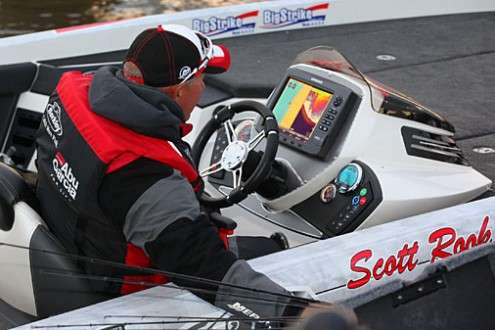
Weeknight tournaments can be fun and prosperous for anglers who make the best use of their time.
Elite pro Scott Rook has competed in hundreds over the years on the Arkansas River near his home. He’s always a threat because of his river experience and ability to maximize his time.
“There’s little time during a three-hour tournament to go looking for fish,” he offered. “You have to have a good idea of what the fish are doing and fish as efficiently as you can.”
For that, Rook proposes a 3-step formula.
1. Fish shallow
River fish like to go shallow, and the ones you find in skinny water are generally active and feeding.
“Especially if there is current —current is going to position those fish in specific areas around shallow cover,” Rook explained.
Rook targets current breaks such as rock jetty points, cuts in the rocks, brush piles, and laying logs along the main river channel.
“Isolated cover that breaks the current can be consistent producers,” he added. “Also, I look for cover that stands out from a long string of cover along a bank Rather than fish the entire stretch, I’ll target that one piece.”
2. Hit a lot of spots
Rook runs a milk route of those subtle, isolated current breaks, hitting only the sweet spots on each one.
“In a three-hour tournament, I may hit 25 spots and only make a few casts to each,” Rook described. “If I catch a fish there, I may spend a little more time, but the object is to cover a lot of water and hit the high percentage spots.”
While a lot of anglers use their electric motor to move down a bank, he jumps to the console and uses the big motor.
Once he establishes a pattern of what the fish are using, he will maximize his time by targeting only those types of places and not fish the entire area. If he catches a couple on grass beds, he goes looking for more grass beds.
“For example, if I’m fishing a rock wall on the main river and catch fish or two in a cut that goes back into a backwater, I will work that with a couple of different lure presentations, then fire up and run to the next one. In a short tournament, you can’t sit on a spot and wait for another one to move in and bite.”
3. Fish smaller baits
River bass tend to target small minnows, so Rook chooses his baits accordingly. Smaller crankbaits and spinnerbaits are his top preferences, bur he will opt for jigs and smaller soft plastics for flipping into cover.
The Strike King KVD 1.5 square bill is one of his favorites. The War Eagle 5/16-ounce spinnerbait with a turtle back blade is another.
“Look at the baitfish in the water and match your lures accordingly,” he added.
For soft plastics, he prefers Texas-rigged tube baits and Zoom’s Baby Brush Hog. He rigs them with a 1/4-ounce sinker.
“I keep my soft plastics moving,” he described. “I pitch in, let it hit the bottom, and then pick it up. I don’t spend a lot of time pitching to a target because I’m looking for that aggressive fish that’s actively feeding and doesn’t have to be coaxed into biting.”
He fishes shad-colored crankbaits and spinnerbaits, but opts for red/black or black/blue soft plastics in stained water. If the water is clearer, he fishes green pumpkin colors.
“The key to successful weeknight tournament fishing is to maximize your time by fishing those baits that match the forage and in places most likely to hold aggressive fish,” said Rook.





